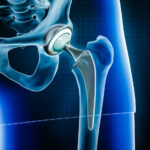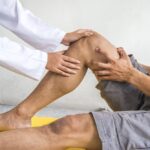In recent years, medical and tech innovations have transformed the methods of orthopedic surgery, offering more accurate solutions to address musculoskeletal conditions. Robotic Partial Knee Replacement (PKR) is also a part of this medical technological revolution, providing high quality treatment for patients suffering from knee arthritis. In India, where the burden of knee osteoarthritis is much more than in the worldthat, the rise of robotic-assisted techniques has gained huge popularity, giving hope for improved treatment. This article by Dr. Simon Thomas, top Knee Replacement Surgeon in Delhi shares the robotic PKR procedure and recovery process.
What is Robotic Partial Knee Replacement?
Robotic Partial Knee Replacement (PKR) is a innovative surgery technique using robotics with partial knee replacement surgery. Unlike total knee replacement, which requires replacing the entire knee joint, partial knee replacement selectively targets the damaged portion of the knee.
Conditions for Robotic Partial Knee Replacement
Robotic PKR is primarily indicated for patients with unicompartmental knee osteoarthritis, where only one compartment of the knee is affected. Unlike in total knee replacement, instead of replacing the complete knee joint, partial knee replacement only replaces the damaged portion, preserving healthy tissue and bone in the unaffected compartments. Common indications for robotic PKR include medial and lateral compartment osteoarthritis and patellofemoral arthritis.
When to consult a Knee Specialist for Robotic Partial Knee Replacement?
If you experience any of the following symptoms given below, immediately check with a good Orthopedician:
- Consistent Knee Pain: Chronic knee pain, especially during weight-bearing activities or at rest, could be a sign of arthritis.
- Swelling and Stiffness: Swelling and stiffness in the knee joint, causing limited motion movement,is a consequence of damaged cartilage.
- Joint Instability: Feeling of joint instability, buckling, or tingling during movement or weight-bearing, Such instability increases risk of falls and injuries.
- Functional Limitations: Difficulty performing routine activities such as walking, climbing stairs, or getting up from a seated position due to knee pain and stiffness warrants
- Progressive Discomfort: Changes in knee alignment, such as bowing or knock-knees, along with the of deformities
The next step is to determine whether consultation with a knee surgeon, specifically one experienced in robotic partial knee replacement, is needed? Consider the following scenarios:
- Failed Treatment: If treatments such as medicines, and physiotherapy, fail improve knee function, it is a time to consult a knee surgeon specializing in joint replacement.
- Progressive Symptoms: If your symptoms continue to worsen over time despite other treatments, it’s essential to asses for surgery options with a knee surgeon. Robotic partial knee replacement offer a good cure for addressing localized arthritis and joint function issues.
- Diagnostic Confirmation: If imaging, such as X-rays or MRI scans, confirms the presence of unicompartmental knee osteoarthritis, consulting a knee surgeon in robotic-assisted techniques is advisable.
How Robotic Partial Knee Replacement in Delhi is Performed by Dr Simon?
The robotic PKR procedure combines imaging with robotic assistance to achieve precision and accuracy. The process begins where high-resolution imaging is used to create a three-dimensional model of the patient’s knee anatomy. This virtual model serves as a guide for the surgeon to assess the extent of arthritis and placement of implants.
During the surgery, the robotic system assists the surgeon in executing it. Through real-time feedback and guidance, the robotic arm ensures bone resection and implant positioning, with reduced errors maximising the reliability of the implants for long-term. The surgeon retains full control throughout the procedure, with the robotic system acting as a tool for reproducibility.
Which Type of Doctors Can Perform Robotic Partial Knee Replacement and How to Choose Them?
Robotic Partial Knee Replacement is typically performed by orthopedic surgeons specialized in joint replacement and trained in robotic-assisted techniques. These factors can be helpful when considering:
1. Expertise: Look for surgeons who have undergone specialised training in robotic-assisted surgery and have a caseload of robotic procedures.
2. Experience: Choose a surgeon with a wealth of experience in performing partial knee replacements, both conventionally and robotically.
3. Hospital or clinic Infrastructure: Opt for hospitals equipped with best in class robotic systems and facilities for optimal care like Dr Simon Thomas’s Knee replacement hospital in Pitampura.
4. Patient Reviews and Testimonials:Seek feedback from previous patients who have undergone robotic PKR under the care of the surgeon
Recovery Time After Robotic Knee Replacement
The recovery time following robotic PKR depends on the magnitude of surgery and overall health. However, compared to traditional knee replacement, robotic-assisted surgery leads to faster recovery and shorter hospital stays.
In Indian where family support and home care becomes part of the recovery, Paitents can be back to normal life within a few weeks to months after robotic PKR.
Dr. Simon Thomas for Partial Knee Replacement Surgery
Dr. Simon Thomas, with over two decades of experience in orthopaedic surgery, has a reputation for excellence in joint replacement procedures. Leading the arthroplasty team at Max Hospital, New Delhi, he brings expertise to the table.
Dr. Thomas’s training both in India and abroad, including stints in Germany, Korea, and Singapore. He has a remarkable track record of over 10,000 successful surgeries.













